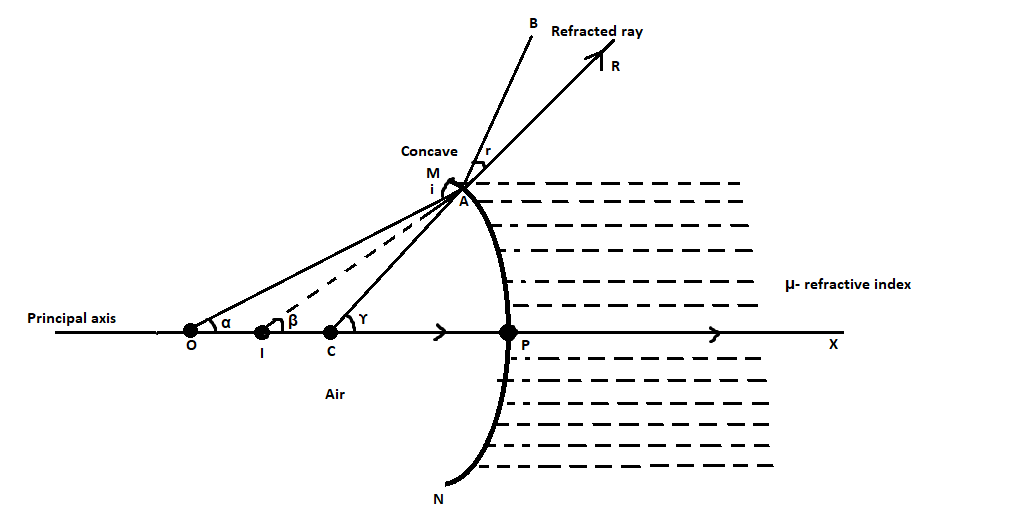Question
Question: Derive the following expression for the refraction at concave spherical surface: \( \dfrac{\mu }{...
Derive the following expression for the refraction at concave spherical surface:
vμ−u1=Rμ−1.
Solution
Hint
A spherical mirror is a part of a sphere with a reflecting surface. If the inner surface is the reflective surface then the mirror is called a concave mirror and if the outer surface is the reflecting surface then the mirror is called a convex mirror. Here we have a concave reflecting surface for which we have to derive the given expression.
Complete step by step answer
Let us consider a concave mirror as shown in the diagram below,

The concave mirror is represented by MPN . The refractive index of the medium of the spherical surface is given by μ . We consider P as the pole of the mirror, O as the centre of curvature, and PC represents the principal axis of the refractive spherical surface. We consider a point object at O . An incident ray travels through C and it is normal to the spherical surface. It will not undergo any refraction hence it will travel in a straight line along PX . Another ray that we consider is OA . It will refract at the point A bending towards the normal. At a point i we will get a virtual image.
Let us consider the ray angles with the principal axis to be α,β , and γ respectively.
According to Snell’s law, we can write the refractive index as
⇒μ=sinrsini
Where i is the angle of incidence and r is the angle of refraction.
Here we have very small i and r , hence we can write,
⇒sini=i And sinr=r in equation
We get,
⇒μ=ri
From this we get,
⇒i=μr
By using the exterior angle theorem, from ΔAOC we get,
⇒γ=i+α
From this we get
⇒i=γ−α
Now, by using exterior angle theorem in ΔIAC , we get
⇒γ=β+r
From this we get,
⇒r=γ−β
Substituting these values of i and r in equation we get,
⇒(γ−α)=μ(γ−β)
For a spherical surface, we can write the angle as
⇒angle=radiusarc
We can write
⇒α=OPPA
And
⇒β=IPPA
Also
⇒γ=CPPA
Substituting these values of α,β and γ in , we get
⇒PCPA−POPA=μ(PCPA−PIPA)
Taking the common terms outside we get,
⇒PA(PC1−PO1)=μPA(PC1−PO1)
⇒PA gets cancelled as it is common on both sides. Now we have
⇒PC1−PO1=μ(PC1−PI1)
Now we have to apply the sign convention.
⇒PC=−R (where R is the radius of curvature)
⇒PI=−v (Where v is the distance of the image from the pole of the mirror)
⇒PO=−u (Where u is the distance of the object from the pole of the mirror)
Putting these values in equation
We get,
⇒(−R1)−(−u1)=μ(−R1+v1)
Opening the brackets on LHS
⇒R−1+u1=μ(R−1+v1)
Opening the brackets on RHS
⇒R−1+u1=Rμ+vμ
Rearranging, we get
⇒R−1+Rμ=vμ−u1
We can write this expression as,
⇒Rμ−1=vμ−u1
Hence we got the required expression for the concave refractive surface.
Note
According to the Cartesian sign convention,
-All distances as measured from the pole of the mirror.
-The distances that are measured in the direction of the incident light are taken as positive.
-The distances that are measured opposite to the direction of incident light is considered as negative.
-The height measured upward the principal axis is measured as positive and the height measured downward is measured negative.
